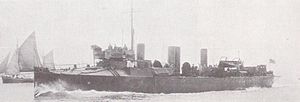Fervent-class destroyer
This article includes a list of general references, but it lacks sufficient corresponding inline citations. (January 2013) |
 HMS Zephyr with four funnels, after reboilering and the addition of three funnels.
| |
| Class overview | |
|---|---|
| Name | Fervent class |
| Builders | Hanna, Donald & Wilson, Paisley |
| Operators | |
| Preceded by | Banshee class |
| Succeeded by | Conflict class |
| Built | 1895 |
| In commission | 1901–1920 |
| Completed | 2 |
| Scrapped | 2 |
| General characteristics | |
| Type | Torpedo Boat Destroyer |
| Displacement | 275 long tons (279 t) |
| Length | 200 ft (61 m) |
| Propulsion | 3,850 shp (2,871 kW) |
| Speed | 27 knots (50 km/h; 31 mph) |
| Complement | 53 |
| Armament |
|
Two Fervent-class destroyers served with the Royal Navy.
Under the 1893–1894 Naval Estimates, the British Admiralty placed orders for 36 torpedo-boat destroyers, all to be capable of 27 knots (50 km/h; 31 mph), the "27-knotters", as a follow-on to the six prototype "26-knotters" ordered in the previous 1892–1893 Estimates. As was typical for torpedo craft at the time, the Admiralty left detailed design to the builders, laying down only broad requirements.[1][2]
HMS Fervent and HMS Zephyr were designed and built by Hanna Donald in 1895. The ships displaced 275 tons and were 200 feet (61 m) long. Their locomotive (later Reed) boilers generated 3,850 shp (2,870 kW) which produced a top speed of between 26 and 27 knots. As was usual with ships of their type, they carried one 12-pounder, two torpedo tubes and had a complement of 53 officers and men.
Both ships served in home waters. They originally were designed with one funnel but when they failed to reach their contract speed they were reboilered with four funnels. Due to these problems, the ships did not leave their builders until 1901.
In September 1913 the Admiralty re-classed all the surviving 27-knotter destroyers, including Fervent and Zephyr as A Class destroyers.
See also
[edit]Citations
[edit]References
[edit]- Chesneau, Roger & Kolesnik, Eugene M., eds. (1979). Conway's All The World's Fighting Ships 1860–1905. London: Conway Maritime Press. ISBN 0-85177-133-5.
- Colledge, J. J.; Warlow, Ben (2006) [1969]. Ships of the Royal Navy: The Complete Record of all Fighting Ships of the Royal Navy (Rev. ed.). London: Chatham Publishing. ISBN 978-1-86176-281-8.
- Donald, William (2012). "A Shipbuilder's Problems: Hanna, Donald, & Wilson and the Early Destroyer". Warship International. XLIX (1): 45–58. ISSN 0043-0374.
- Friedman, Norman (2009). British Destroyers: From Earliest Days to the Second World War. Barnsley, UK: Seaforth Publishing. ISBN 978-1-84832-049-9.
- Gardiner, Robert & Gray, Randal, eds. (1985). Conway's All The World's Fighting Ships 1906–1921. London: Conway Maritime Press. ISBN 0-85177-245-5.
- Lyon, David (2001) [1996]. The First Destroyers. London: Caxton Editions. ISBN 1-84067-364-8.
- Manning, T. D. (1961). The British Destroyer. Putnam & Co. OCLC 6470051.
- March, Edgar J. (1966). British Destroyers: A History of Development, 1892–1953; Drawn by Admiralty Permission From Official Records & Returns, Ships' Covers & Building Plans. London: Seeley Service. OCLC 164893555.
